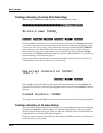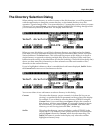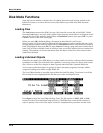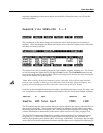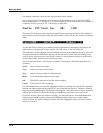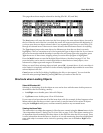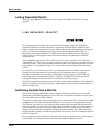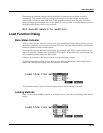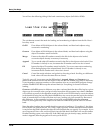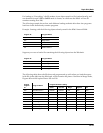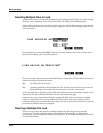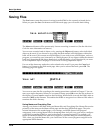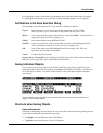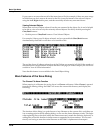
13-20
Basic Disk Mode
Load Function Dialog
You will see the following dialog if the bank contains any objects (in RAM or ROM):
||||||||||||||||||||||||||||||||||||||||
||||||||||||||||||||200...299*||||||||||
||||||||||||||||||||300...399|||||||||||
||Load|this|file|as:400...499*||||||||||
||||||||||||||||||||500...599|||||||||||
||||||||||||||||||||600...699|||||||||||
||||||||||||||||||||700...799|||||||||||
OvFill|Overwrt|Merge|Append|Fill||Cancel
The soft buttons control the mode for loading and renumbering of objects from the file. Here’s
how they work:
OvFill First deletes all RAM objects in the selected bank, and then loads objects using
consecutive numbering.
Overwrt First deletes all RAM objects in the selected bank, and then loads objects using the
object ID numbers stored in the file.
Merge Preserve the object ID numbers stored in the file for the objects to be loaded,
overwrite objects already in memory if necessary.
Append Try to use the object ID numbers stored in the file for the objects to be loaded. If an
ID number is already in use, increment the ID number until a free slot is found.
Fill Ignore the object ID numbers stored in the file. Try to use consecutive numbering
from the beginning of the selected bank. If an ID number is already in use,
increment the ID number until a free slot is found.
Cancel Cancel the mode selection, and go back to choosing a bank. Scrolling to a different
bank value will have the same effect as Cancel.
Typically, you will just want to use the Fill method. Append, Merge, and Overwrt try to
preserve the numbers stored with the objects in the file, but this should only really be necessary
if you depend on program numbers or effect numbers to be at a certain MIDI program change
number. OvFill is like Fill except the selected bank (or Everything) is cleared out before
loading.
Overwrt and OvFill operate in different ways after a selected bank has been filled up for a given
object type (for example, after you have loaded more than 100 programs into a bank). Overwrt
will continue to preserve the objectIDs stored in the file, and will individually overwrite objects
in the bank following the just filled bank. OvFill does not overwrite past the end of the selected
bank; it instead skips over object IDs that are in use, loading only into unused IDs. Because of
this difference, it can sometimes be faster to load a file using OvFill rather than Overwrt.
However, this applies only if the objects to be loaded would extend past the end of a selected
bank.
Note that when loading into a specific bank (as opposed to loading as “Everything”), the object
IDs in the file are used as follows: The “bank” digit is ignored, and the remainder of the number
is used when the K2661 rebanks the object ID into the bank that you specify. For example, if you
save Program 453 into a file, and load it back into the 300s bank, the K2661 will use the number
53 when deciding upon a new object ID. If the 300s bank was previously empty, and the load
mode is Append, then the program will end up with ID 353.



